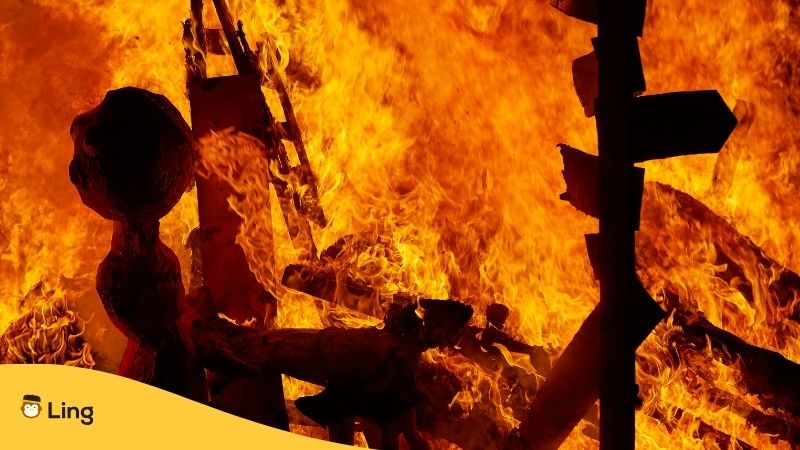You’ve likely seen photos of people in colorful costumes wielding massive fire torches or wooden ladders ablaze with fire – that iconic scene comes from none other than Japan’s famous Omihachiman Sagicho Fire Festival!
Every March, the small riverside town of Omihachiman ignites for a night unlike anywhere else. Hundreds of eager participants wearing traditional outfits battle along the old samurai district canals in the festival’s namesake event: “sagicho.” This friendly competition sees teams face off to try to nab a sash or marker hanging from tall bamboo ladders set aglow by flickering firelight. It’s 400 years of history and tradition boiled into one fiery, fun-filled night!
I’m here to give you the full scoop on everything you need to know about one of the deadliest festivals in this country. I’ll also share some useful words in the Japanese language to truly enjoy the fest.

What Is Omihachiman Sagicho Fire Festival?
The Omihachiman Sagicho Festival takes place every year on March 14th in and around the Himure Hachimangu Shrine (日牟禮八幡宮) in the city of Omihachiman, Shiga Prefecture. The history behind Sagicho is uncertain – some accounts say it was started by the famous warlord Oda Nobunaga back in the 1500s as a fiery celebration. Others believe locals began the tradition after Oda’s death to celebrate the burning of his castle.
Regardless of its origins, the festival commemorates deep traditions, and many believe it represents the burning of bad luck and the welcoming of springtime. Hundreds of costumed participants keep this iconic piece of old Japan alive through their enthusiastic battles and celebrations.
What Happens During The Omihachiman Sagicho Fire Festival?
The excitement builds in the weeks before the festival as Omihachiman’s 13 former samurai neighborhoods each build towering floats made of straw, bamboo, and paper. This friendly competition has them working for months to create the most elaborate sagicho float to be judged best in show!
On the day of Sagicho, costumed dancers with colorful masks and painted faces lead the floats through the streets to Himure Shrine. Once the winning neighborhood is announced, the massive floats are set ablaze right along the moat to cheering crowds! Flames spark high into the night sky while dancers wearing protective hoods fearlessly perform around the towering infernos.
In addition to the fiery floats, teams take to the shrine streets to battle in the namesake sagicho activity. Wielding 5-meter tall bamboo ladders decorated with their neighborhood symbols, they face off trying to snatch a sash from the top of the opposing team’s ladder. These mock battles inject excitement and laughter into the crowd between the burning of the floats.
The flames, costumes, dances, and mock battles all celebrate the warding off of bad luck and welcoming of spring. It’s a dangerous, dramatic, and magical night – no wonder hundreds of visitors brave the flames each year to witness Sagicho traditions passed down for over 400 years!
How To Get To The Omihachiman Sagicho Fire Festival?
Getting to Omihachiman to experience the exhilarating Sagicho Fire Festival is easy! The town is located in Shiga Prefecture, making it very accessible whether you’re coming from Kyoto, Tokyo, or elsewhere in Japan.
If coming from Kyoto, simply hop on the JR Shin Kaisoku Express train, which gets you to Omihachiman Station in just 33 minutes. Those coming from Tokyo can also ride the speedy Tokaido Shinkansen bullet train to Maibara Station in around an hour and 45 minutes. From there, transfer to the JR Tokaido Main Line headed to Omihachiman Station – just a short and scenic 25-minute ride.
Once arriving at Omihachiman Station, Sagicho’s main site is just a few minutes away.
What Is The Relevance Of The Fire Festival?
It’s no coincidence that fire plays such a central role in traditional Japanese festivals like Sagicho. Fire has long had cultural and spiritual significance in Japan. Many shrines and temples hold annual fire rituals to ward off evil spirits and bring good fortune. These fiery traditions also celebrate the cleansing and renewing properties of fire – out with the old bad luck and in with the new and positive!
Fire is also intrinsically tied to the natural world and seasonality in Japan. The flickering flames of Sagicho welcome the coming of Spring and represent burning the last of Winter’s frost away. Other fire festivals mark the Fall Harvest, when flames light up rice field edges to give thanks for bountiful crops.

Easy Japanese Words Related To Fire
Part of the fun of attending a famous festival like Sagicho is learning key words and phrases to fully immerse yourself! Here are some easy Japanese vocabulary terms related to fire that you’re sure to hear while exploring the action:
火 (Hi) – Fire
This one is essential – you’ll be hearing it often around those towering infernos.
燃える(Moeru) – To Burn
Listen for this as locals cheer on the burning sagicho floats.
火祭り(Himatsuri) – Fireworks
The fireworks filling Sagicho’s night sky are no ordinary hanabi, but the more dramatic himatsuuri.
輝く(Kagayaku) – To Shine/Sparkle
Those costumes, fireworks and floats will have plenty of joyful kagayaku!
炎上(Enjou) – Blaze/Flames
Expect some impressive enjou roaring from the canal-side torches and pyres.
熱心 (Nesshin) – Excitement
You can’t help but be filled with fiery nesshin energy at Sagicho Festival!
Use your new vocab words to yell encouragement to sagicho teams, remark on those magnificent bursts of flames, and express your awe at the sparkling costumes. A little language goes a long way towards fully immersing yourself in all the exhilaration!
Learn Japanese With Ling
If witnessing the exhilarating passion, history, and magic of the Omihachiman Sagicho Fire Festival hasn’t already convinced you to hop on a flight to Japan, I don’t know what will! This iconic centuries-old tradition capturing old samurai district fire rituals, spiritual celebrations, and seasonal change is an experience like no other.
Want to get started on your Japanese language skills to better immerse yourself when attending festivals or navigating Japan? Download the Ling app! Ling’s bite-sized Japanese lessons let you build practical travel vocabulary at your own pace. Say arigatō and konnichiwa with confidence. Learn key words related to getting around, ordering food, asking for help and more.



































































